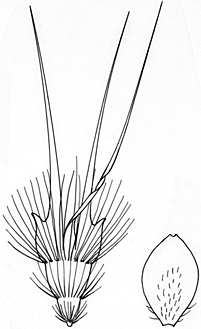Common name: Lobed Wallaby Grass
Rytidosperma auriculatum (J.M.Black) Connor & Edgar APNI* Synonyms: Austrodanthonia auriculata (J.M.Black) H.P.Linder APNI*
Danthonia auriculata J.M.Black APNI*

Description: Slender, caespitose perennials, erect or somewhat geniculate especially at the lower nodes, to 50 cm tall.
Culms smooth, usually much exceeding the leaces, c. 3-noded. Sheaths pilose; ligule reduced to a ring of short cilia, c 0.5 mm long, often pilose with longer hairs at the sides; blade 2–10 cm long, fine, inrolled, or occasionally flat, more or less densely pilose.
Inflorescence much exserted, obliquely ovate. c. 4 cm long, compact but spikelets not numerous, sometimes reduced to a raceme. Spikelets c. mostly 6-flowered, pale greenish tinged with purple, the florets much shorter than the glumes except for the tip of the awns. Glumes with a distinct membranous margin, 9–11-nerved, 9–16 mm long. Lemmas 3.5–4 mm long, obscurely 9-nerved, glabrous, hairy; lateral lobes firm, 3-nerved, acuminate; central awn shortly exceeding the lateral lobes at maturity, more or less twisted and often brown below the joint, pale and flexose above; palea oblong to broad-oblanceolate or obovate. pilose on the back.
Distribution and occurrence: Usually grows on open plains with loamy or clay soil, in natural pastures.
NSW subdivisions: ST, CWS, SWS, SWP
Other Australian states: Vic. S.A.
This grass has considerable economic importance.
Text by Louisa Murray
Taxon concept: Jacobs, S.W.L., Whalley, R.D.B. & Wheeler, D.J.B. Grasses of New South Wales, Fourth Edition (2008).
APNI* Provides a link to the Australian Plant Name Index (hosted by the Australian National Botanic Gardens) for comprehensive bibliographic data
***The AVH map option provides a detailed interactive Australia wide distribution map drawn from collections held by all major Australian herbaria participating in the Australian Virtual Herbarium project.
|


